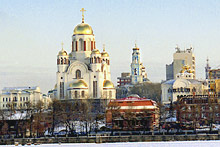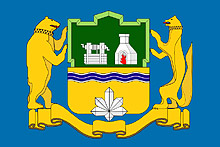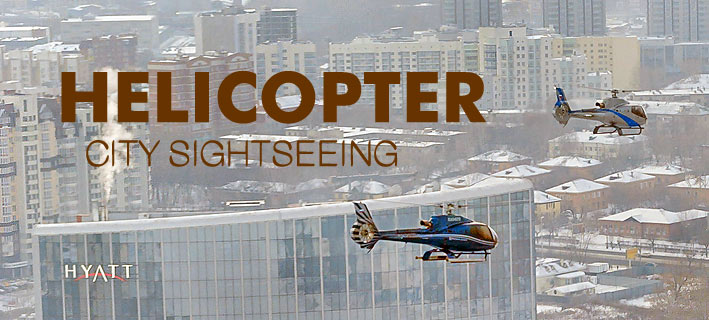Ekaterinburg
Ekaterinburg (also known as Yekaterinburg) is the third largest Russian city, administrative centre of the Sverdlovsk region and the capital of the Urals. Sverdlovsk oblast is one of the most developed and advanced regions in Russia. It is very rich in minerals and raw materials - the main industries are heavy machinery and metallurgy. It is situated far from areas of ethnic conflict and is politically stable.
Ekaterinburg can easily be found on a geographical map of the vast Euro-Asian Continent: it is in the middle of the Ural mountains, which separate Europe and Asia. The Europe-Asia Obelisk which is about 25 miles (40kms) west of the city, marking the border between the two continents, is an especially interesting place to visit. Thus, Ekaterinburg lies at the crossroad of 2 continents and this determines its political, economic and cultural peculiarities.
Ekaterinburg is the capital of the Ural Federal District, which covers an area of about 2 million sq. km. The territory possesses the main oil and gas fields of Russia, and the richest deposits of iron and polymetallic ores. The world largest metallurgical enterprises are located in the Urals, concentrating here due to the great industrial and intellectual potential. The Sverdlovsk region (and Ekaterinburg as its main city) exports raw materials and heavy machinery and imports foodstuff, consumer goods and machines. Business and investment climate is believed to be favorable.
Ekaterinburg is a candidate city to host the World Expo 2020

If you visit the city Ekaterinburg, we are glad to offer you some excursions
in Ekaterinburg and its environs. All of these programmes start in Ekaterinburg.
For some impressions from our guests who have visited the Urals, please click here
Time shift: Moscow +2 hours, GMT +5 hours
Climate: The fact that Ekaterinburg is far away from the Atlantic Ocean and close to Siberia makes the climate here continental. Compared to the western part of European Russia, which is situated on the same latitudes, we have a longer and colder winter, the temperature difference between days and nights is bigger and the humidity is lower. The climate is mostly affected by the “Western wave” - atlantic air on its way to the Urals becomes continental - it loses it’s humidity and becomes colder in winter or warmer in summer. Nevertheless air currents from the west bring most part of atmospheric precipitation and western cyclones often change the weather in Ekaterinburg region. The Ural Mountains also have a big impact on the weather of the region. The mountains are stretched out across the path of the western waves. The mountains, which are not very high, don't make an obstacle for the waves but significantly slow them down, helping the air to move in northerly or southerly directions.
Ekaterinburg has long cold winters with January being the coldest month with temperatures averaging –16C/-17C but it can, on rare occasions, drop to minus 40C. The first snow-falls are in the beginning of October, and the city is usually covered by early November. The heavy snows take until April to thaw. July is the warmest month with average temperatures around 20C – but temperatures of 38C have been recorded. Swimming in the lakes and rivers of the southern and middle Ural is possible from June till August.
Summer ends in late August when the first frosts come to the Urals, however, an “Indian Summer” which is experienced in mid September is quite comfortable.

History
In 2013 we will celebrate the 290th anniversary of the city. Originally established by the Russian Emperor, Peter the Great, as a major industrial and administrative centre and it has remained so for nearly three centuries.
The glory of the foundation of Ekaterinburg is shared by two "fledglings of Peter's nest" - Captain Vasilij Tatishchev who determined the location of the plant/fortress, and the engineer and general of artillery, William de Gennin, who later put the plant into operation. On November 7 (18), 1723 two iron-forging hammers were put into operation in the hammer-forging shop of the plant. This event was registered as the official date of birth of the town named after the Saint Martyr Catherine (Ekaterina in Russian), the patroness of mining crafts, and after the reigning empress who had been baptized Catherine by the Russian Orthodox Church.
Soon the Ekaterinburg Metallurgical Works became famous for its high quality metal, both in Russia and around the world. In 1728 a mint was opened in its territory, which coined Russian money for a century and a half. A year later a gem-processing factory was built here, which brought world fame to Ural precious and semi-precious stones.
At first Ekaterinburg belonged to the Tobolsk region, however, in 1781 it was granted the status of a town within the Perm principality. In 1783 the Senate approved its coat of arms. The upper part of the shield in this coat of arms displayed a bear with the New Testament on its back against the background of red which was to symbolize that the town belonged to the Perm region, while the lower part showed a silver smelting furnace and a mine against the background of green which symbolized the abundance of minerals near the town. In 1807 Ekaterinburg was granted a unique status of a mining city. It had its own mining courts and mining police, Catherine's Mining Cathedral, the main mining pharmacy, and a town garrison directly subordinated to the Head of the Mining Plants of the Ural Mountain Range. It was only in 1863 that the town was returned to civilian rule.
At the same time, Ekaterinburg was turning into a centre of non-mining industries and banking business. The discovery of Siberian gold brought about a fabulous wealth to the city and stimulated its growth. For a long time the mining of this gold was the monopoly of the Ekaterinburg merchants - the Ryazanovs, Rastorguyevs, Balandins, and others.
Situated on the border between Europe and Asia the town also played an important mediating role in trade. Initially, one part of the fortress, and then of the town, was called a “Trade” part. In 1843 the State Commercial Bank opened its branch office in Ekaterinburg; the “Siberian”, the “Volga-Kama”, and the “City Community Banks” began operating here early in the XXth century.
Despite its provincial character, the town was a major cultural center. It had a mining school, a mining research society, and a mining museum. 1843 was the year of the establishment of the town's first theatre company, for which, four years later, the citizens constructed a theatre building on Glavny Prospect (Main Street). In 1870, the Ural Society of Science Enthusiasts was established whose members published works about the Ural region and organized expeditions. The national crisis caused by World War I, the February revolution and the October upheaval radically changed the fate of the town. On October 26, 1917 Soviet Power was proclaimed in Ekaterinburg.
Before the civil war Ekaterinburg became a regional centre, and in 1923 it was granted it’s rights, and in 1923 it was granted the rights of the administrative centre of the huge, newly established Ural region.
In 1924 the name of Ekaterinburg disappeared from the map of the country. As the totalitarian regime grew stronger it gave the names of its leaders to all places, big and small. Thus, Ekaterinburg was renamed “Sverdlovsk” and in 1934 it became the main city of the region bearing the same name.
Throughout the 1920s - 1930s Ekaterinburg preserved its significance as an industrial and cultural centre of the Urals. The construction of huge plants brought about a threefold increase in its population. The Sverdlovsk builders constructed dozens of industrial buildings, blocks of flats, schools, shops and hospitals. In 1925 the city got its first water supply line and first bus routes. In 1929 the first tram appeared on its streets and a broadcasting station was put into operation. High-rise buildings became the sign of the time.
In 1940, the city had 12 institutions of higher learning, 30 technical schools, 100 secondary schools, 166 libraries, 7 museums, and 5 theatres.
Sverdlovsk was turning into a city of big science. In 1932 the USSR Academy of Sciences opened its branch here. During the years of World War II the city was turned into a powerful arsenal of military equipment and armaments. The leading enterprises of the city were converted to military production. Sverdlovsk gave refuge to the People's Commissariat of Nonferrous Metallurgy, the Presidium of the USSR Academy of Sciences, the Air-Force Academy, the Central Theatre of Soviet Army, the famous Moscow MHAT theatre, and the unique collections of the Hermitage.
Many thousands of Sverdlovskians fought on the fronts of the Great Patriotic War. Over 100, 000 citizens were decorated with orders and medals and 55 were granted the title “Hero of the Soviet Union”.
After the war Sverdlovsk continued to develop as a large industrial centre in the Urals. Its industrial plants and factories were important suppliers for machine engineering, ferrous and nonferrous metallurgy, chemistry, electrical engineering, and light and food industries. The city was rapidly growing and in 1967 its millionth resident was born.
On November 18, 1978 the people of Sverdlovsk celebrated the Day of the City for the first time - now it is a traditional popular festival.
On September 4, 1991 the city was returned to its original name – Ekaterinburg
Currently the population of Ekaterinburg stands at approximately 2 million. There are more than 100 research institutes headed by the Ural Branch of the Russian Academy of Sciences, 15 higher educational establishments, 35 technical schools (colleges), 27 vocational schools, 5 theatres, a philharmonic concert hall, about 600 libraries, and 15 stadiums.
 Modern Emblem of Ekaterinburg Modern Emblem of Ekaterinburg
The upper part of the shield is in the shape of a fortress, as Ekaterinburg was a fortress during the first years of its existence. The wavy azure line at the bottom is the river Iset, which connects the past and the present, Europe and Asia. The bear is a European symbol and the sable is an Asian one. During Demidov’s times, the sable was the trademark of the Ural’s metal. The animals, which are not within the borders of the shield, show their tongues and expose their teeth and this demonstration of aggression can be explained that they are defending the city. The golden ribbon at the very bottom of the emblem is considered to characterise Ekaterinburg as a metropolitan city.
Romanov's Dynasty in Ekaterinburg. Ekaterinburg is known as the city where the last Russian tsar, Nicolas II, and his family were killed by Bolsheviks in 1918.
Some facts: After the February Russian revolution in 1917 Nicholas II was arrested and sent to the city Tobolsk in Siberia, and later to Ekaterinburg. By August 1918, Russia was in a flame of Civil War - Red and White Armies fought with alternating success. The White Army enraptured Ekaterinburg and there was a direct threat of the tsar's release, so the Bolsheviks decided to kill him and his family and hide their remains.
Romanov's family
On July 16, 1918, former tsar Nicholas II, his wife Alexandra, their four daughters, Tsarevich Alexis, and their faithful servants, Doctor Botkine, lady-in-waiting Anna Demidova, cook Kharitonov and footman Troup were assassinated in Ipatiev house’s basement in Ekaterinburg.
Their remains were taken away to the forest outside the town. Trying to hide remains, they burned the bodies, tried to dissolve them in acid and finally threw them in a flooded collapsed mine.
Later they decided to move the remains and hide them in a deeper mine but because of the attacking White Army they had to throw the bodies under a road. This place was hidden, and no investigations were successful until 1979 when the tsar’s remains were discovered - but for political reasons they could not be exhumed. Exactly one day after taking power in 1991, Boris Yeltsin, the first Russian president, retrieved the remains, and the identification process began. Many teams of experts - Russian, British and American investigated them with DNA expertise for 10 years and came to conclusion that the bones were in fact those of Nicolas, Alexandra, Olga, Tatiana, Anastasia and the four servants.
Ipatiev house was destroyed to avoid it becoming a place of pilgrimages by a special order of the communist party in 1977.
On the place of Ipatiev house the “Cathedral-on-the-Blood” has been built. It is now the biggest Cathedral in Ekaterinburg –it’s grand opening on July 16th, 2003 – the 85th anniversary of the tragedy, became the greatest city event this year. You can see all the Romanov’s places: “Cathedral-on-the-Blood” (the place of tsar’s family) and Holy Royal Martyrs Monastery (“Ganina Yama”), founded on the place of tsar’s family burial.

What is Interesting in the city?
There are a lot of places of interest in Ekaterinburg - it has a unique mixture of different architectural, historical, and cultural rarities, which may never be repeated. More than 60 monuments of history and culture are located in the city, and 43 of them are considered to be national monuments because of their special significance. That is why Ekaterinburg can claim the formal status as “Russia's most historical city”.
At present, Ekaterinburg is one of Russia's biggest industrial centres. It’s enterprises produce industrial goods for heavy machinery and chemical plant construction, for transportation, and military purposes.
Ekaterinburg is not very old, but over the course of its 280-year history, it has proven itself to be a special and even unique city – not only by it’s geographical location, but also by a role as one of the founders of Russian industry. The heart of Ekaterinburg is its dam, which permitted the initial development of the city's industrial base. It was first erected in 1723 and has been reconstructed twice since – now it is recognized as an industrial monument of the 18th century.
Unfortunately, very few buildings of the old factory area have been preserved. Those that do, house the Museum of History, Architecture, and Technology of the Urals, and the Natural Museum - both of which are located in the so-called “Historical Park”. The oldest building of Ekaterinburg, which dates from 1764 and recently reconstructed, is also situated here. At present this is the Fine Arts Museum. Ekaterinburg of the 18th century was a wooden city, however, the city's first buildings of stone construction also appeared here during this period. At most these were administrative buildings - for example, the Main Board of the mining factories, where the Urals Conservatory is located now.
In the late 18th and the early 19th centuries a new architectural style – “classicism”, influenced Ekaterinburg landscapes. The palace on Voznesenskaya Hill, with its luxurious park, is the most famous example of this style. Many churches and chapels made the city's panorama very beautiful and picturesque. In the beginning of the 20th century there were about 50 churches, of which only 6 still stand today.
There are quite a few buildings in the “constructivist” style within the city - typical of this are such examples as the Main Post Office, the "Uralskij Rabochij” (“Ural Worker”) printing house, the movie studio, the famous White Tower, the "Dinamo" recreational centre, etc.
The Soviet period brought new trends to Ekaterinburg's architecture - luxury and rationalism, which reflected the influence both of ideology and asceticism. New tendencies in the development of world architecture have also affected the city. Some of the most well known structures of this time include the Military Headquarters, the Ural Great Polytechnic University, the Railroad Administrative Building, and the Philharmonic Theatre.
The city's history is full of events -many expeditions to Siberia, Central Asia and the Far East passed through Ekaterinburg.
The city was visited by many Russian tsars and members of their families.
The first Russian president, Boris Yeltsin lived and worked here during the 1960s and 1970s.
Among the many monuments in Ekaterinburg are the monuments to Bolshevik “Malyshev” and "The Black Tulip" - Russian soldiers during the Afghan campaign named the aeroplanes which delivered the coffins of their dead comrades back to Russia “The Black Tulips”.
There are so many remarkable places in the 290-year-old Ekaterinburg, that all cannot possibly be described in this small web site. This brief information is intended to provoke the interest of Ekaterinburg's inhabitants and guests of the Urals to the history of our remarkable city.
Some helpful, curious or just unique articles about the city:
Ekaterinburg by Wikipedia, the free encyclopedia
Walk around the city: heart of Ekaterinburg by Edgar Blanco
Night Ekaterinburg in motion by Dmitry Krylov
 
|

